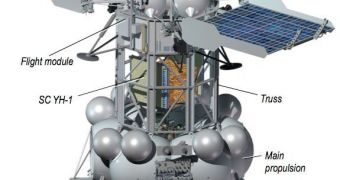Officials at the Russian Federal Space Agency (RosCosmos) announce that the Phobos-Grunt mission will be launched from the Baikonur Cosmodrome, in Kazakhstan, on November 9. Launch will occur at 00.26 am Moscow time (2026 GMT, November 8).
The sample-return mission will be delivered to space aboard a Zenit-2SB rocket. Astronomers agree that this is one of the most ambitious space exploration missions ever attempted. Only two sample-return missions were ever completed successfully, of which one ended just last year.
In short, RosCosmos plans to put the Phobos-Grunt spacecraft in orbit around the diminutive Martian moon Phobos. From this position, the orbiter will launch a small lander to the surface of the object.
The tiny robot will then scoop up some material from Phobos' surface, and store it inside a specialized container. After this stage of the mission is completed, the return capsule will start its journey back to Earth, reenter our planet's atmosphere, and be recovered by Russian scientists.
RosCosmos has had a sort of fascination with Phobos for decades, but past missions it sent to the small moon have all failed. Even Phobos-Grunt was supposed to launch years ago, but a series of problems prevented the spacecraft from taking off, Universe Today reports.
In its final configuration, the space probe weighs about 12,000 kilograms (26.455 pounds). Its cruise stage, or main propulsion module, has already been fueled up, at Baikonur's Facility 31 building.
RosCosmos engineers also fueled the Yinghou-1 mini-satellite – which was developed by the China National Space Administration (CNSA) – and which will accompany Phobos-Grunt on its long-duration flight to Mars.
The Zenit-2SB booster rocket has already been stacked inside Facility 42 at Baikonur. A few days from now, the spacecraft will be moved inside this building as well, and encapsulated inside its protective fairing. The entire structure will then be mated with the delivery system.
At this point, experts estimate that Phobos-Grunt will need about 11 months to complete its journey to Mars, reaching the Red Planet around September 2012. After achieving orbital insertion around the moon, the spacecraft will spend the next few months searching for a suitable landing spot.
This represents the first Mars-bound mission that RosCosmos attempts in more than 20 years. All of its previous attempts have failed for a variety of reasons, and this made the agency focus on projects closer to home, such as the International Space Station.
However, Phobos-Grunt represents just the first of a new generation of exploration spacecraft. Russia has big plans for analyzing a number of other objects in our solar system.

 14 DAY TRIAL //
14 DAY TRIAL //